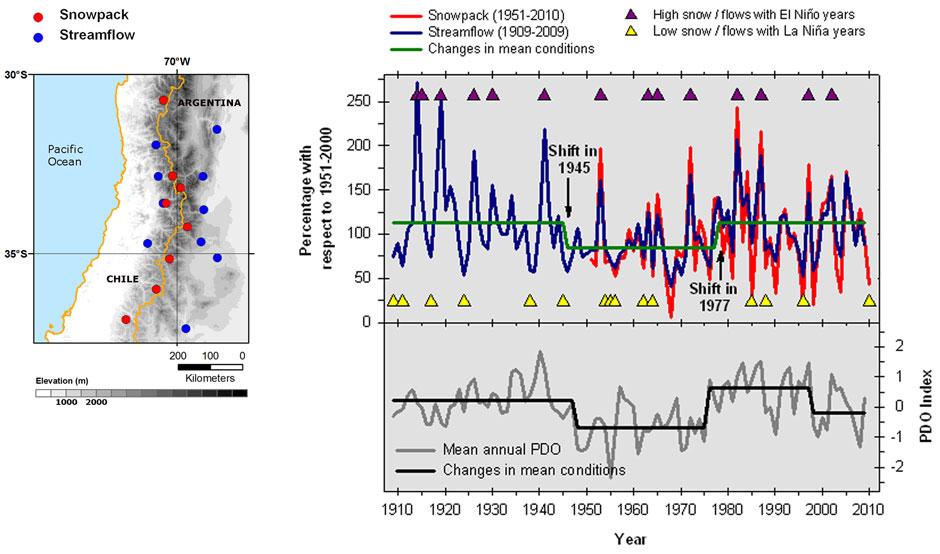Pacific sea surface temperatures affect Andean snowpack and water supply to the semi-arid central Chile and Argentina
Pacific sea surface temperatures affect Andean snowpack
and water supply to the semi-arid central Chile and Argentina
The graph shows winter snowpack (red line) and river streamflow (blue line) in the Chilean and Argentinean Andes between 30 and 37° South at the measuring stations on the map to the left. El Niño years (purple triangles) correspond with high snowpack and streamflow, and La Niña years with low snow and flows (yellow triangles). The green line shows average streamflow for 1910-1944, 1945-1976, and 1977-2010. The timing of mean shifts coincides with shifts in the 1940s and 70s in the Pacific Decadal Oscillation (PDO, lower diagram).
The Andean snowpack is the most important water resource for semi-arid central Chile and central-western Argentina. Understanding the variability and controls of Andean snowpack and the resulting streamflow is critical for water management in the lowlands. In addition to the well-known influence of El Niño-Southern Oscillation (ENSO) we show an association with the low-frequency changes of the Pacific Decadal Oscillation (PDO). This relationship warrants further investigation. Knowledge of the complex interplay between ENSO and low frequency climate variations such as the PDO is important for evaluating future water availability. Reconstruction of streamflow or snowpack variations based on tree rings and other proxy data can provide a long-term perspective on the high and low frequency patterns on which global warming trends will likely be superimposed.
Science Snapshots 10 – The Story
Andean snow melt is the most important source of water for households, agriculture, industry, hydro power and ecosystems in semi-arid central Chile and central-western Argentina. Mariano Masiokas and Ricardo Villalba from IANIGLA-CONICET, Argentina, and Brian Luckman of the University of Western Ontario, Canada, provided a detailed analysis based on regional composite data of maximum winter snow accumulation and mean annual river discharges: the close relation between regionally averaged snowpack (red line) and streamflow (blue line) shows that snowmelt is the origin of most of the annual streamflow in this part of the Andes.
Winter snowpack and streamflow are both related to large-scale changes in Pacific surface temperature associated with ENSO and PDO. Years with high snowpack and streamflow coincide with warm El Niños in the tropical Pacific (purple triangles above the graph). Most, but not all, extreme dry years occur during cold La Niña events (yellow triangles below); 1968, 1990 and 2004 are exceptions. Major changes in the PDO over the North Pacific in the mid 1940s and in 1976-77 (black line, bottom graph) coincide with a 27% decrease (1945) and a 28% increase (1977) in mean annual river discharges (green line, upper graph). The timing of these shifts and streamflow patterns suggests that the multi-decadal behavior of the PDO causes low-frequency hydrologic variations in the Andes of central Chile and Argentina.
Lower PDO values in the late 1990s are not matched by the regional streamflow record. This might be due to an increasing contribution from melting glaciers, but more detailed glaciological, hydrological and meteorological data are required. In North America the most extreme precipitation patterns were found to occur when PDO and ENSO are in phase (Gershunov et al. 1999). Thus El Niño years in a positive PDO phase might have particularly high snowpacks. Although these relationships have still to be explored for the southern Andes, such oscillations should be taken into account to improve forecasts and preparedness for future water scarcity under changing climate and increasing demand.
Further reading
Gershunov, A., Barnett, T. J. and Cayan D.R. (1999) North Pacific Interdecadal Oscillation Seen as Factor in ENSO-Related North American Climate Anomalies. EOS 80(3), 25-30.
Masiokas, M. H., R. Villalba, B. H. Luckman, C. Le Quesne, J.C. Aravena (2006) Snowpack variations in the Central Andes of Argentina and Chile, 1951-2005: Large-scale atmospheric influences and implications for water resources in the region. Journal of Climate, 19, 6334-6352.
Masiokas, M.H., R. Villalba, B.H. Luckman, S. Mauget (2010) Intra- to Multidecadal Variations of Snowpack and Streamflow Records in the Andes of Chile and Argentina between 30° and 37°S. Journal of Hydrometeorology, 11 (3), 822-831.
Global Change Science Snapshots are intended to inform IAI clients and the interested public about important results of international research carried out under IAI auspices.
Editorial Board: Paula Richter, Holm Tiessen, Ione Anderson
Design: Shadi Ardalan
Cite as: IAI (2012): Pacific sea surface temperatures, Andean snowpack and water supply to the semi-arid regions of Chile and Argentina. Science Snapshots 10
Funded by IAI, NSF under CRN 2047

